
- 算法设计与分析
- 家
- 算法基础知识
- DAA - 简介
- DAA - 算法分析
- DAA-分析方法
- 渐近符号和先验分析
- 时间复杂度
- 马斯特定理
- DAA - 空间复杂性
- 分而治之
- DAA-分而治之
- DAA - 最大最小问题
- DAA-归并排序
- DAA-二分查找
- 施特拉森矩阵乘法
- 唐叶算法
- 河内塔
- 贪心算法
- DAA-贪婪法
- 旅行商问题
- Prim 的最小生成树
- 克鲁斯卡尔的最小生成树
- Dijkstra 的最短路径算法
- 地图着色算法
- DAA-分数背包
- DAA - 带截止日期的作业排序
- DAA - 最佳合并模式
- 动态规划
- DAA-动态规划
- 矩阵链乘法
- 弗洛伊德·沃歇尔算法
- DAA - 0-1 背包
- 最长公共子序列
- 旅行商问题| 动态规划
- 随机算法
- 随机算法
- 随机快速排序
- 卡格的最低削减
- 费舍尔-耶茨洗牌
- 近似算法
- 近似算法
- 顶点覆盖问题
- 设置封面问题
- 旅行推销员近似算法
- 排序技巧
- DAA-快速排序
- DAA-冒泡排序
- DAA——插入排序
- DAA-选择排序
- DAA——希尔排序
- DAA-堆排序
- DAA——桶排序
- DAA——计数排序
- DAA - 基数排序
- 搜索技巧
- 搜索技术介绍
- DAA - 线性搜索
- DAA-二分查找
- DAA - 插值搜索
- DAA - 跳转搜索
- DAA - 指数搜索
- DAA - 斐波那契搜索
- DAA - 子列表搜索
- DAA-哈希表
- 图论
- DAA-最短路径
- DAA - 多级图
- 最优成本二叉搜索树
- 堆算法
- DAA-二叉堆
- DAA-插入法
- DAA-Heapify 方法
- DAA-提取方法
- 复杂性理论
- 确定性计算与非确定性计算
- DAA-最大派系
- DAA - 顶点覆盖
- DAA - P 级和 NP 级
- DAA-库克定理
- NP 硬课程和 NP 完全课程
- DAA - 爬山算法
- DAA 有用资源
- DAA - 快速指南
- DAA - 有用的资源
- DAA - 讨论
设计与分析——堆排序
堆排序是一种基于堆排序的高效排序技术
堆是一个近乎完整的二叉树,其中父节点可以是最小的也可以是最大的。具有最小根节点的堆称为最小堆,具有最大根节点的堆称为最大堆。堆排序算法的输入数据中的元素使用这两种方法进行处理。
堆排序算法在此过程中遵循两个主要操作 -
根据排序方式(升序或降序),使用heapify (本章将进一步解释)方法从输入数据构建堆 H。
删除根元素的根元素并重复,直到处理完所有输入元素。
堆排序算法
堆排序算法很大程度上依赖于二叉树的heapify方法。那么这个heapify方法是什么呢?
堆化法
二叉树的heapify方法就是将二叉树转换为堆数据结构。该方法使用递归方法来堆化二叉树的所有节点。
注意- 二叉树必须始终是完全二叉树,因为它必须始终有两个子节点。
通过应用heapify方法,完整的二叉树将转换为最大堆或最小堆。
要了解有关 heapify 算法的更多信息,请单击此处。
堆排序算法
正如下面的算法所述,排序算法首先通过调用Build-Max-Heap算法构造堆ADT,并删除根元素以将其与叶子处的最小值节点交换。然后应用 heapify 方法相应地重新排列元素。
Algorithm: Heapsort(A) BUILD-MAX-HEAP(A) for i = A.length downto 2 exchange A[1] with A[i] A.heap-size = A.heap-size - 1 MAX-HEAPIFY(A, 1)
分析
堆排序算法是另外两种排序算法的组合:插入排序和归并排序。
与插入排序的相似之处在于,任何时候只有恒定数量的数组元素存储在输入数组之外。
堆排序算法的时间复杂度为O(nlogn),类似于归并排序。
例子
让我们看一个示例数组以更好地理解排序算法 -
| 12 | 3 | 9 | 14 | 10 | 18 | 8 | 23 |
使用 BUILD-MAX-HEAP 算法从输入数组构建堆 -
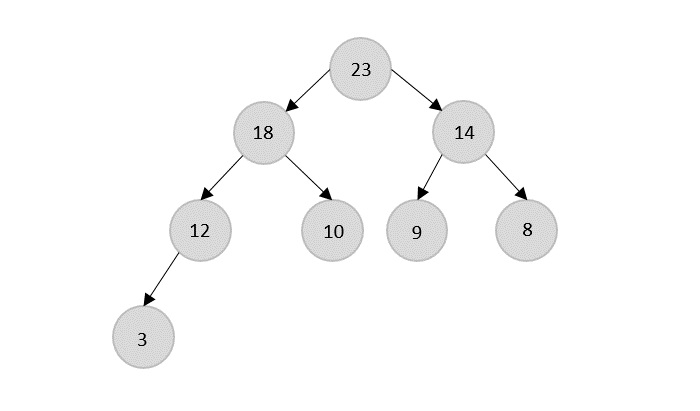
通过交换节点重新排列得到的二叉树,形成堆数据结构。
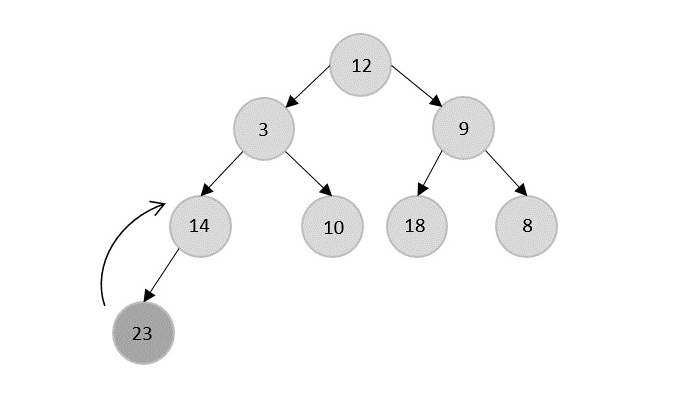
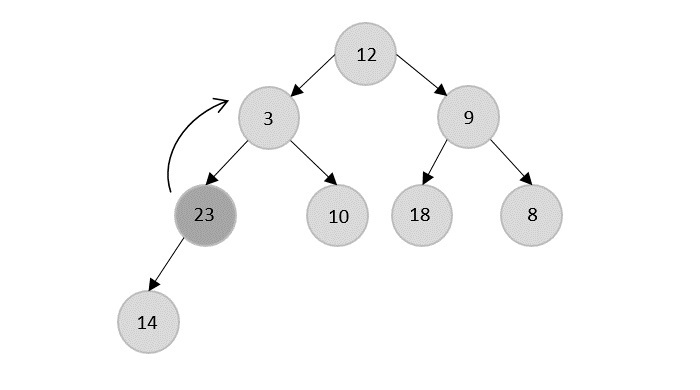
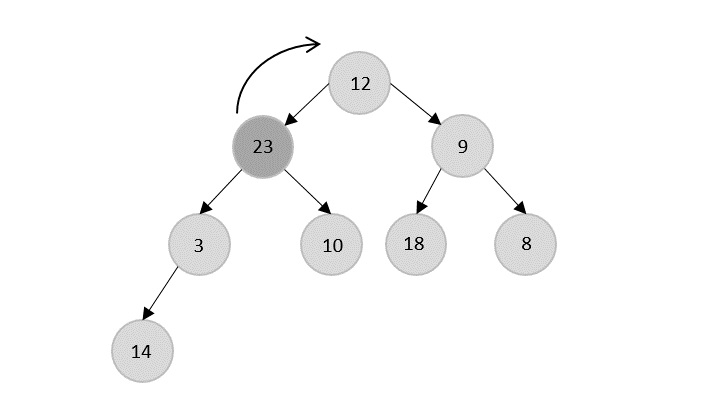
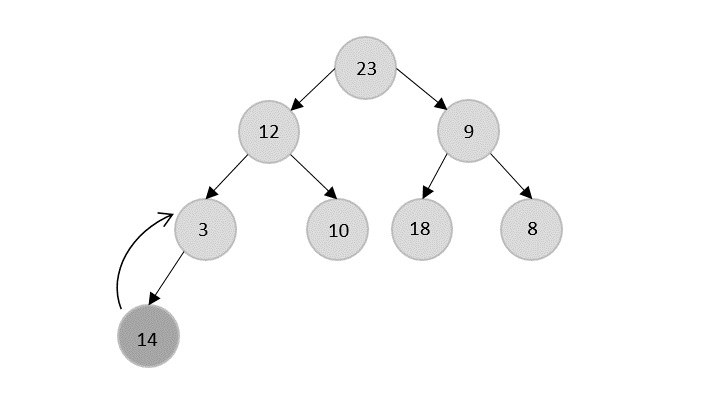
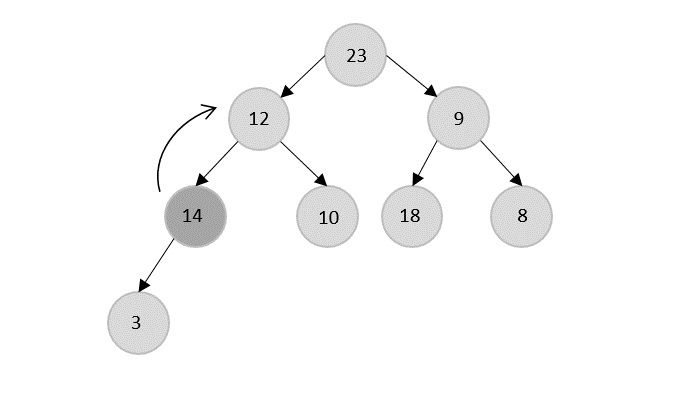
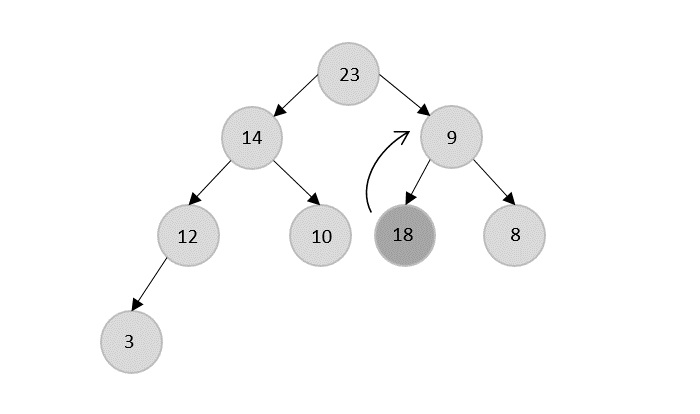

堆排序算法
应用 heapify 方法,从堆中删除根节点,并将其替换为根的下一个直接最大值子节点。
根节点是 23,因此 23 被弹出,18 成为下一个根,因为它是堆中的下一个最大节点。
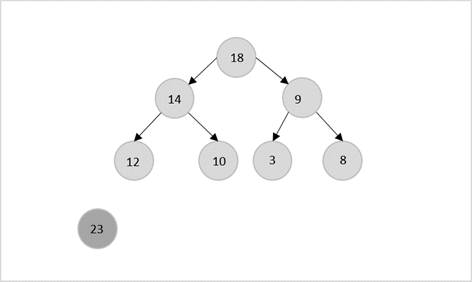
现在,18 在 23 之后被弹出,被 14 取代。
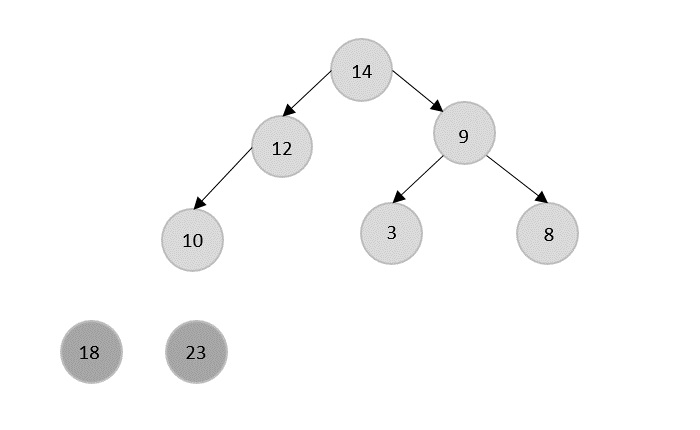
当前根 14 从堆中弹出并替换为 12。
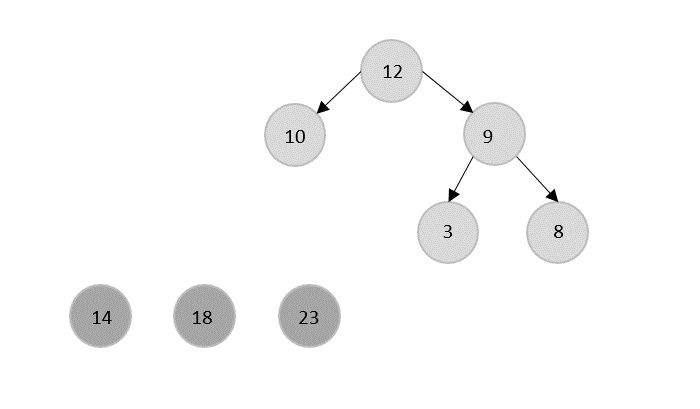
12 被弹出并替换为 10。
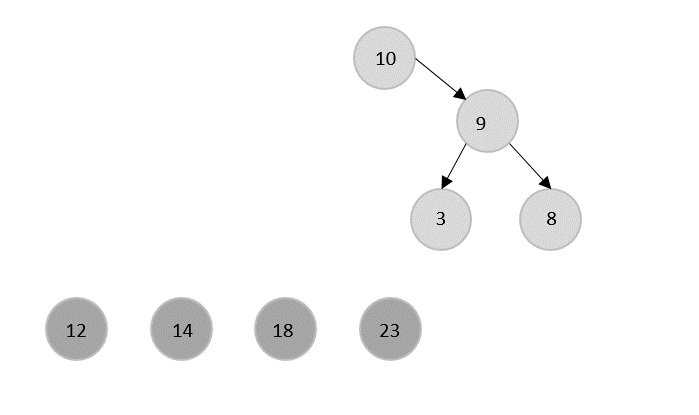
类似地,所有其他元素都使用相同的过程弹出。
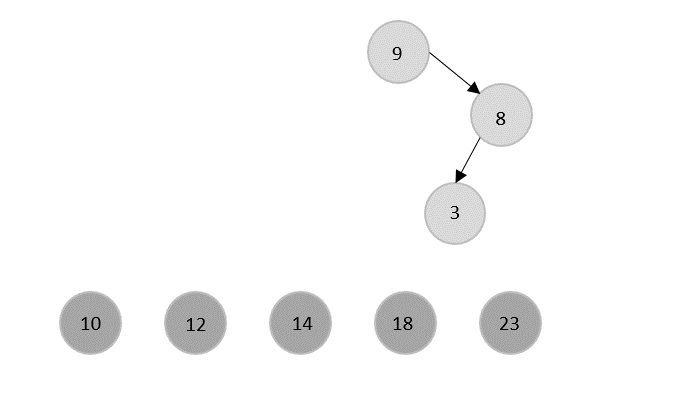
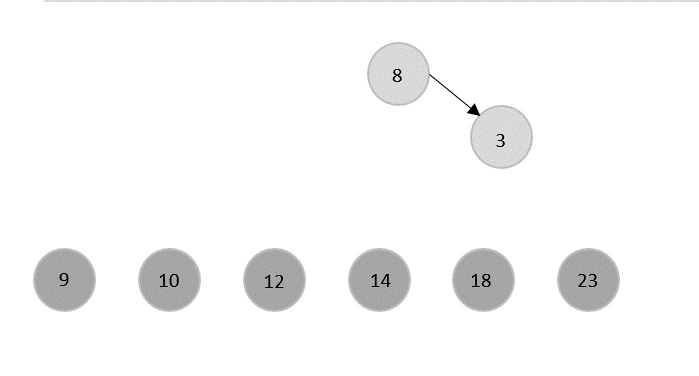
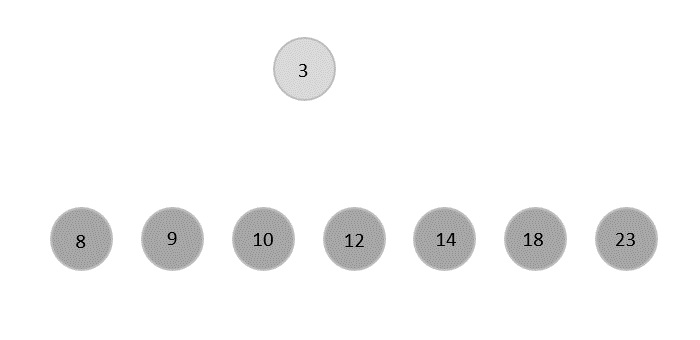
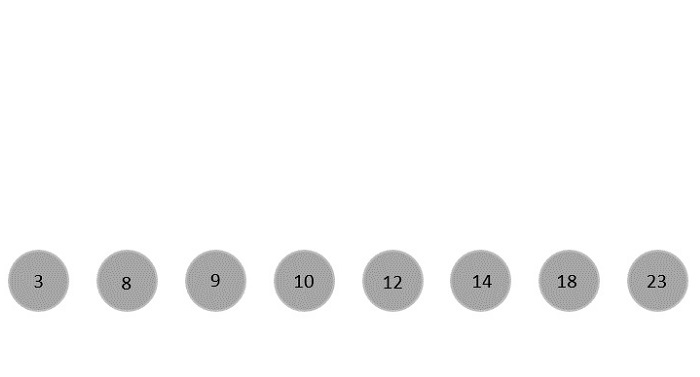
每次弹出一个元素时,它都会添加到输出数组的开头,因为形成的堆数据结构是最大堆。但如果 heapify 方法将二叉树转换为最小堆,则将弹出的元素添加到输出数组的末尾。
最终的排序列表是,
| 3 | 8 | 9 | 10 | 12 | 14 | 18 | 23 |
执行
堆排序的实现逻辑是:首先,根据 max-heap 属性构建堆数据结构,其中父节点的值必须大于子节点的值。然后从堆中弹出根节点,并将堆上的下一个最大节点移动到根。该过程不断迭代,直到堆为空。
在本教程中,我们展示了四种不同编程语言的堆排序实现。
#include <stdio.h>
void heapify(int[], int);
void build_maxheap(int heap[], int n){
int i, j, c, r, t;
for (i = 1; i < n; i++) {
c = i;
do {
r = (c - 1) / 2;
if (heap[r] < heap[c]) { // to create MAX heap array
t = heap[r];
heap[r] = heap[c];
heap[c] = t;
}
c = r;
} while (c != 0);
}
printf("Heap array: ");
for (i = 0; i < n; i++)
printf("%d ", heap[i]);
heapify(heap, n);
}
void heapify(int heap[], int n){
int i, j, c, root, temp;
for (j = n - 1; j >= 0; j--) {
temp = heap[0];
heap[0] = heap[j]; // swap max element with rightmost leaf element
heap[j] = temp;
root = 0;
do {
c = 2 * root + 1; // left node of root element
if ((heap[c] < heap[c + 1]) && c < j-1)
c++;
if (heap[root]<heap[c] && c<j) { // again rearrange to max heap array
temp = heap[root];
heap[root] = heap[c];
heap[c] = temp;
}
root = c;
} while (c < j);
}
printf("\nThe sorted array is: ");
for (i = 0; i < n; i++)
printf("%d ", heap[i]);
}
int main(){
int n, i, j, c, root, temp;
n = 5;
int heap[10] = {2, 3, 1, 0, 4}; // initialize the array
build_maxheap(heap, n);
}
输出
Heap array: 4 3 1 0 2 The sorted array is: 0 1 2 3 4
#include <iostream>
using namespace std;
void heapify(int[], int);
void build_maxheap(int heap[], int n){
int i, j, c, r, t;
for (i = 1; i < n; i++) {
c = i;
do {
r = (c - 1) / 2;
if (heap[r] < heap[c]) { // to create MAX heap array
t = heap[r];
heap[r] = heap[c];
heap[c] = t;
}
c = r;
} while (c != 0);
}
cout << "Heap array: ";
for (i = 0; i < n; i++)
cout <<heap[i]<<" ";
heapify(heap, n);
}
void heapify(int heap[], int n){
int i, j, c, root, temp;
for (j = n - 1; j >= 0; j--) {
temp = heap[0];
heap[0] = heap[j]; // swap max element with rightmost leaf element
heap[j] = temp;
root = 0;
do {
c = 2 * root + 1; // left node of root element
if ((heap[c] < heap[c + 1]) && c < j-1)
c++;
if (heap[root]<heap[c] && c<j) { // again rearrange to max heap array
temp = heap[root];
heap[root] = heap[c];
heap[c] = temp;
}
root = c;
} while (c < j);
}
cout << "\nThe sorted array is : ";
for (i = 0; i < n; i++)
cout <<heap[i]<<" ";
}
int main(){
int n, i, j, c, root, temp;
n = 5;
int heap[10] = {2, 3, 1, 0, 4}; // initialize the array
build_maxheap(heap, n);
return 0;
}
输出
Heap array: 4 3 1 0 2 The sorted array is : 0 1 2 3 4
import java.io.*;
public class HeapSort {
static void build_maxheap(int heap[], int n) {
for (int i = 1; i < n; i++) {
int c = i;
do {
int r = (c - 1) / 2;
if (heap[r] < heap[c]) { // to create MAX heap array
int t = heap[r];
heap[r] = heap[c];
heap[c] = t;
}
c = r;
} while (c != 0);
}
System.out.println("Heap array: ");
for (int i = 0; i < n; i++) {
System.out.print(heap[i] + " ");
}
heapify(heap, n);
}
static void heapify(int heap[], int n) {
for (int j = n - 1; j >= 0; j--) {
int c;
int temp = heap[0];
heap[0] = heap[j]; // swap max element with rightmost leaf element
heap[j] = temp;
int root = 0;
do {
c = 2 * root + 1; // left node of root element
if ((heap[c] < heap[c + 1]) && c < j-1)
c++;
if (heap[root]<heap[c] && c<j) { // again rearrange to max heap array
temp = heap[root];
heap[root] = heap[c];
heap[c] = temp;
}
root = c;
} while (c < j);
}
System.out.println("\nThe sorted array is: ");
for (int i = 0; i < n; i++) {
System.out.print(heap[i] + " ");
}
}
public static void main(String args[]) {
int heap[] = new int[10];
heap[0] = 4;
heap[1] = 3;
heap[2] = 1;
heap[3] = 0;
heap[4] = 2;
int n = 5;
build_maxheap(heap, n);
}
}
输出
Heap array: 4 3 1 0 2 The sorted array is: 0 1 2 3 4
def heapify(heap, n, i):
maximum = i
l = 2 * i + 1
r = 2 * i + 2
# if left child exists
if l < n and heap[i] < heap[l]:
maximum = l
# if right child exits
if r < n and heap[maximum] < heap[r]:
maximum = r
# root
if maximum != i:
heap[i],heap[maximum] = heap[maximum],heap[i] # swap root.
heapify(heap, n, maximum)
def heapSort(heap):
n = len(heap)
# maxheap
for i in range(n, -1, -1):
heapify(heap, n, i)
# element extraction
for i in range(n-1, 0, -1):
heap[i], heap[0] = heap[0], heap[i] # swap
heapify(heap, i, 0)
# main
heap = [4, 3, 1, 0, 2]
heapSort(heap)
n = len(heap)
print("Heap array: ")
print(heap)
print ("The Sorted array is: ")
print(heap)
输出
Heap array: [0, 1, 2, 3, 4] The Sorted array is: [0, 1, 2, 3, 4]